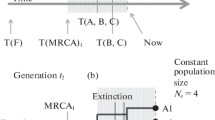Abstract
The biological species concept deals both with the meaning of the sexual species as a harmonious gene pool and with its protection against deleterious outbreeding (effected by isolating mechanisms). According to the Darwin-Muller-Mayr theory isolating mechanisms are acquired by incipient species during alloparty. Isolating mechanisms are not the result of ad hoc selection, but of a change of function of properties acquired during the preceding isolation of the incipient species. The role of behavioral properties (“recognition”) among the isolating mechanisms has long been recognized and described by naturalists but was rejected as basis of a species definition for a number of valid reasons.
Similar content being viewed by others
Bibliography
Darwin, F., and Seward, A. C.: 1903,More Letters of Charles Darwin. 2 vols. London: Murray.
Dobzhansky, Th.: 1935, A critique of the species concept in biology.Philosophy of Science 2, 344–355.
Dobzhansky, Th.: 1937,Genetics and the Origin of Species. New York: Columbia University Press.
Dobzhansky, Th.: 1950, Mendelian populations and their evolution.Amer. Nat. 84, 401–418.
Dobzhansky, Th., and E. Mayr: 1944, Experiments on sexual isolation in Drosophila. I. Geographic strains ofDrosophila willistoni.Proceedings of the National Academy of Sciences 30, 238–244.
Mayr, Ernst: 1942,Systematics and the Origin of Species. New York: Columbia University Press.
Mayr, Ernst: 1946a, Experiments on sexual isolation in Drosophila. VI. Isolation betweenDrosophila pseudoobscura andDrosophila persimilis and their hybrids.Proc. Nat. Acad. Sci. 32(3), 57–59.
Mayr, Ernst: 1946b, Experiments on sexual isolation in Drosophila. VII. The nature of the isolating mechanisms betweenDrosophila pseudoobscura andDrosophila persimilis.Proc. Nat. Acad. Sci. 32(5), 128–137.
Mayr, Ernst: 1949, Speciation and systematics. In G. L. Jepsen, E. Mayr, and G. G. Simpson.Genetics, Paleontology, and Evolution. Princeton, N.J.: Princeton University Press, pp. 281–298.
Mayr, Ernst: 1950, The role of the antennae in the mating behavior of femaleDrosophila.Evolution IV(2), 149–154.
Mayr, Ernst: 1957, Species concepts and definitions. In E. Mayr (ed.),The Species Problem (Amer. Assoc. Adv. Sci. Publ. No. 5): 371–388.
Mayr, Ernst: 1959, Isolation as an evolutionary factor.Amer. Phil. Soc. 103(2), 221–230.
Mayr, Ernst: 1960, The emergence of evolutionary novelties, pp. 349–380 in S. Tax, (ed.).Evolution After Darwin, Vol. I. Chicago: University of Chicago Press.
Mayr, Ernst: 1961, [Discussion]. In W. F. Blair,Vertebrate Speciation. Austin, TX: University of Texas Press.
Mayr, Ernst: 1963,Animal Species and Evolution. Cambridge: Harvard University Press.
Mayr, Ernst: 1969, The biological meaning of species.Biol. J. Linn. Soc. 1: 311–320.
Mayr, Ernst: 1984, Evolution of fish flock species: A commentary. In A. A. Echelle and I. Kornfield (eds.).Evolution of Fish Species Flocks. Orono, ME: University of Maine at Orono Press, pp. 3–11.
Mayr, Ernst: 1986, The species as category, taxon and population.Histoire du Concept D‘espèce dans les sciences de la vie. Colloque international (May 1985) organisé par la Fondation singer-Polignac. Paris: Fondation Singer-Polignac, pp. 303–320.
Mayr, Ernst, and Th. Dobzhansky: 1945: Experiments on sexual isolation in Drosophila. IV. Modification of the degree of isolation betweenDrosophila pseudoobscura andDrosophila persimilis and of sexual preferences inDrosophila prosaltans.Proc. Nat. Acad. Sci. 31(2), 75–82.
Muller, H. J.: 1942, Isolating mechanisms, evolution and temperature.Biol. Symp. 6, 71–125.
Paterson, H. E.: 1973, Animal species studies.J. Roy. Soc. Western Australia 36, 31–36.
Paterson, H. E.: 1978, More evidence against speciation by reinforcement.S. Afri. J. Sci. 74, 369–371.
Paterson, H. E.: 1980, A comment on ‘mate recognition systems’Evolution 34, 330–331.
Paterson, H. E.: 1981, The continuing search for the unknown and the unknowable.S. Afri. J. Sci. 77, 113–119.
Paterson, H. E.: 1982, Perspective on speciation by reinforcement.S. Afri. J. Sci. 78, 53–57.
Paterson, H. E.: 1985, The recognition concept of species. In E. S. Vrba (ed.),Species and Speciation. Transvaal Museum Monograph 4: 21–29.
[Paterson, H. E.]: 1986, Environment and species.S. Afri. J. Sci. 82, 62–65.
Patterson, J. T., and W. S. Stone: 1952,Evolution in the Genus Drosophila, New York: Macmillan.
Plate, L.: 1914, Prinzipien der Systematik mit besonderer Berücksichtigung des Systems der Tiere.Kultur der Gegenwart 3(4), 119–159.
Poulton, E.: 1908,Essays on Evolution, 1889–1907. Oxford: Clarendon Press.
Raubenheimer, D., and T. M. Crowe: 1987, The recognition concept: is it really an alternative?S. Afri. J. Sci. 83, 530–534.
Author information
Authors and Affiliations
Rights and permissions
About this article
Cite this article
Mayr, E. The Why and How of Species. Biol Philos 3, 431–441 (1988). https://doi.org/10.1007/BF00647963
Issue Date:
DOI: https://doi.org/10.1007/BF00647963




